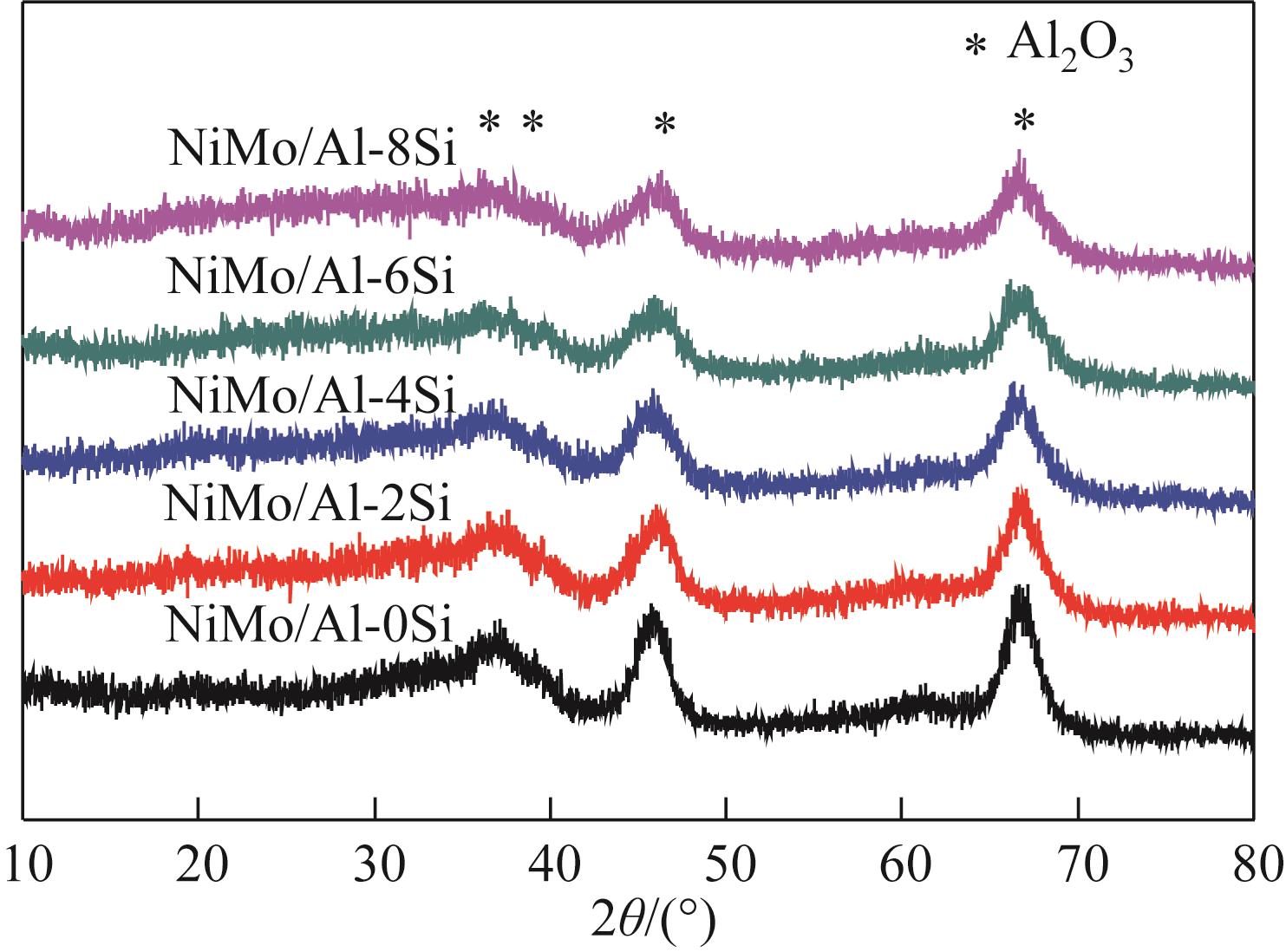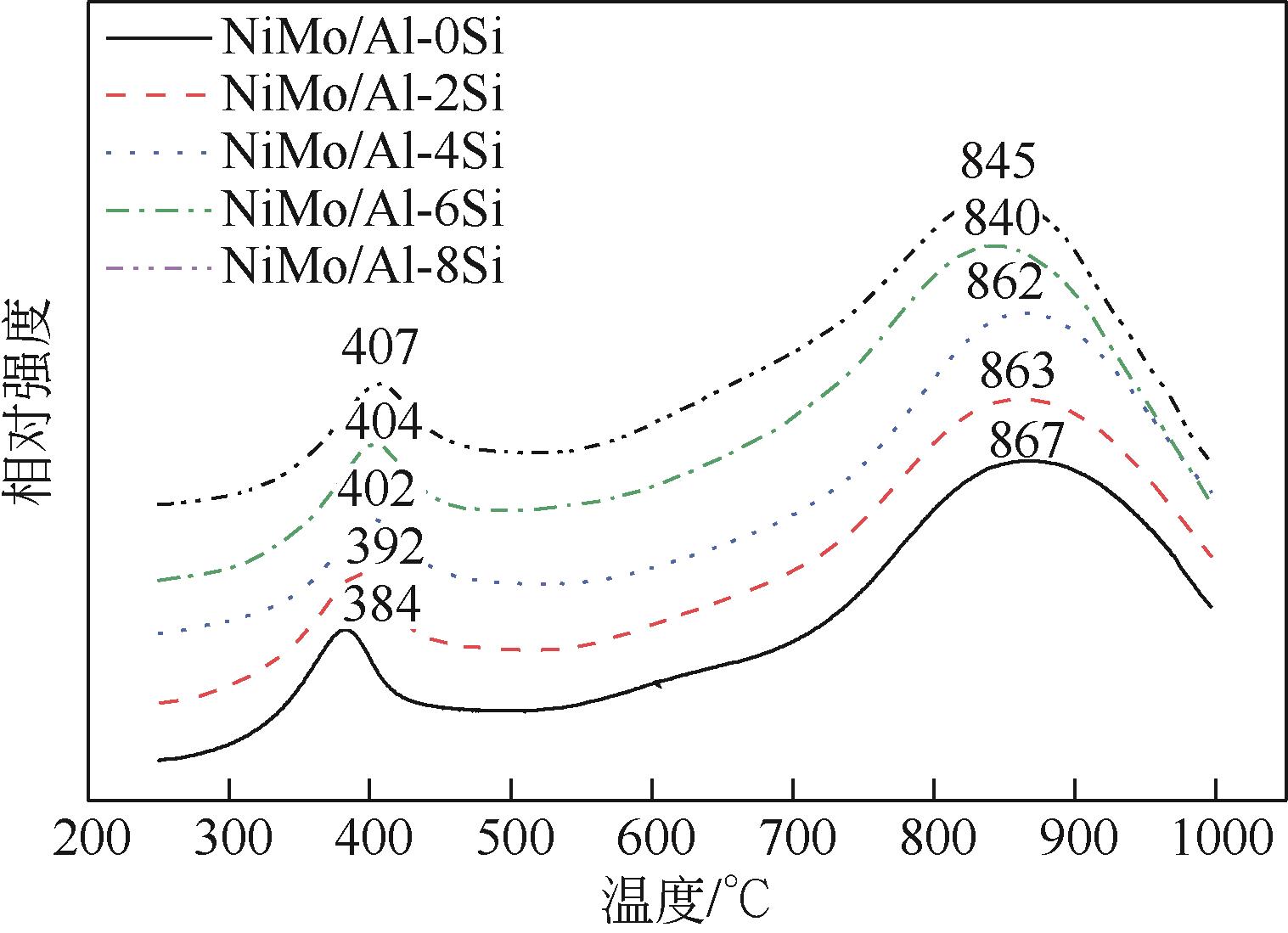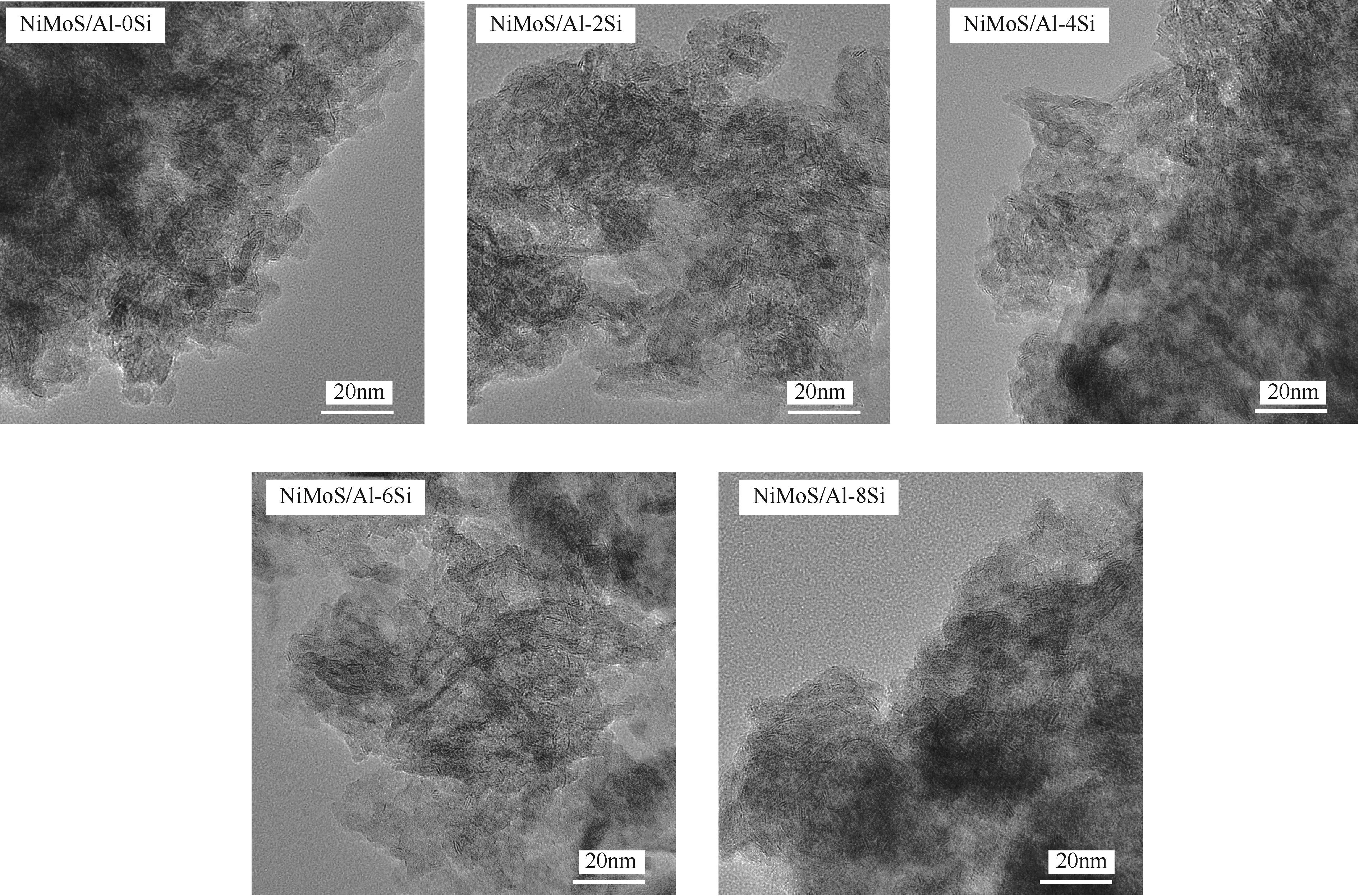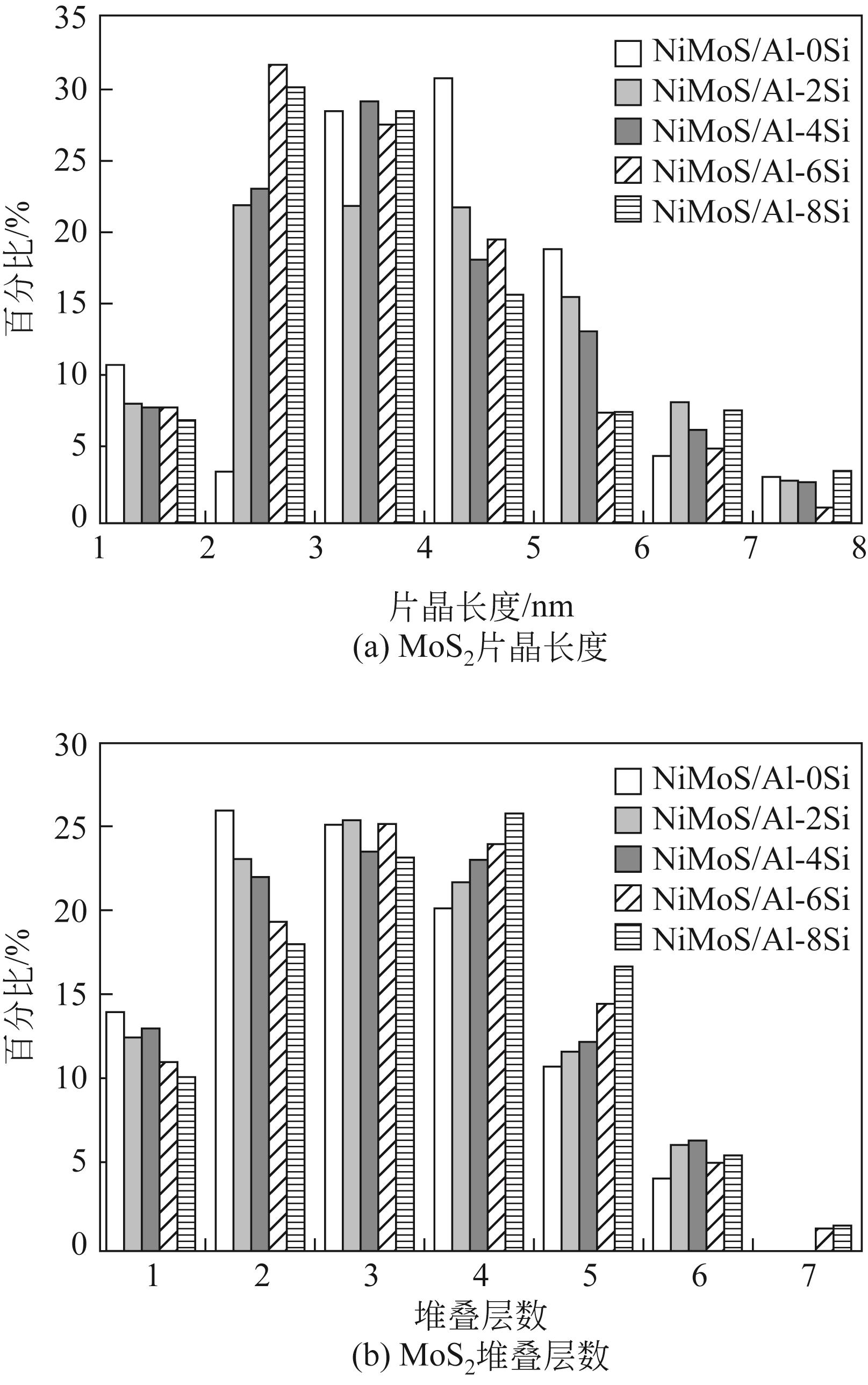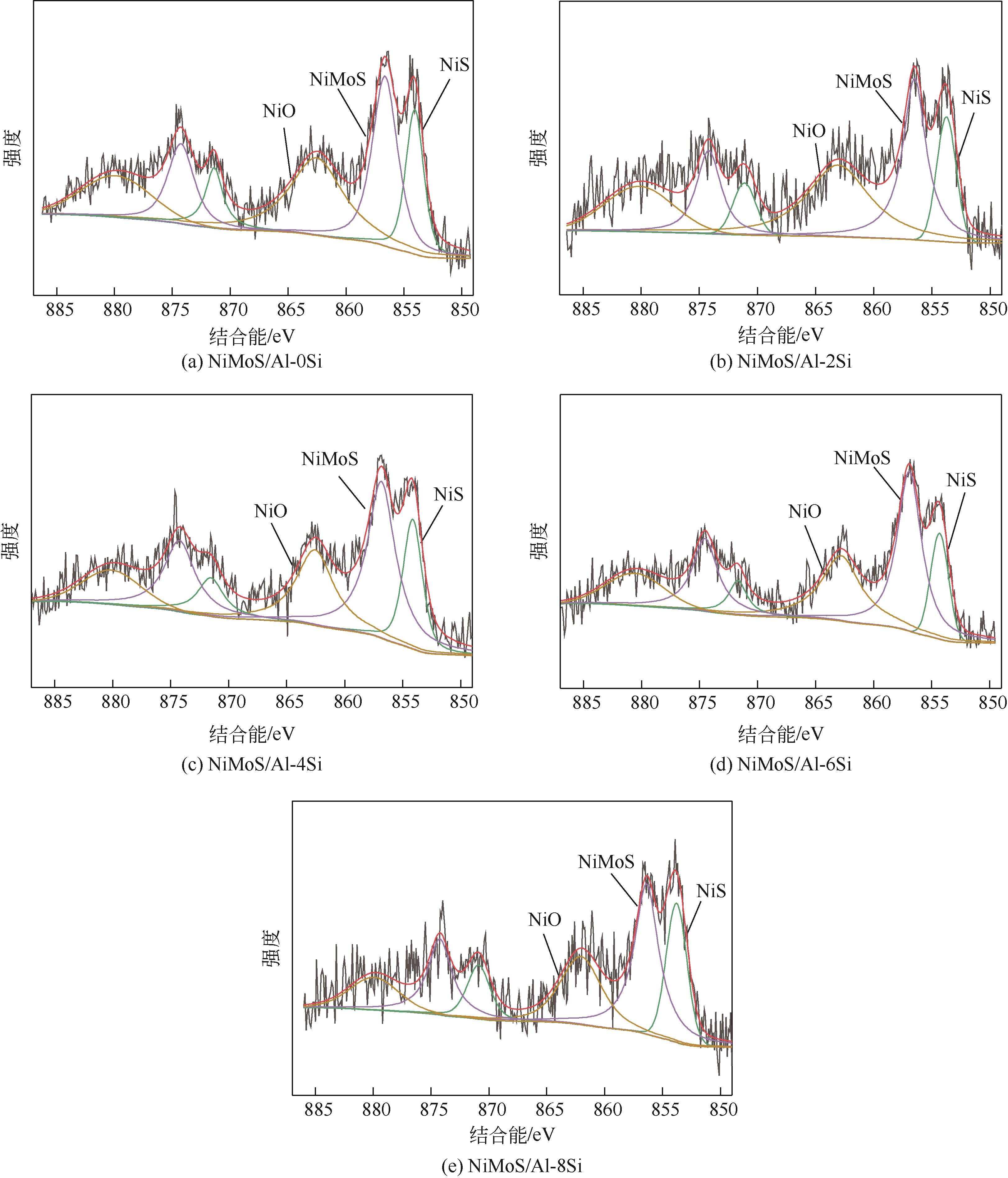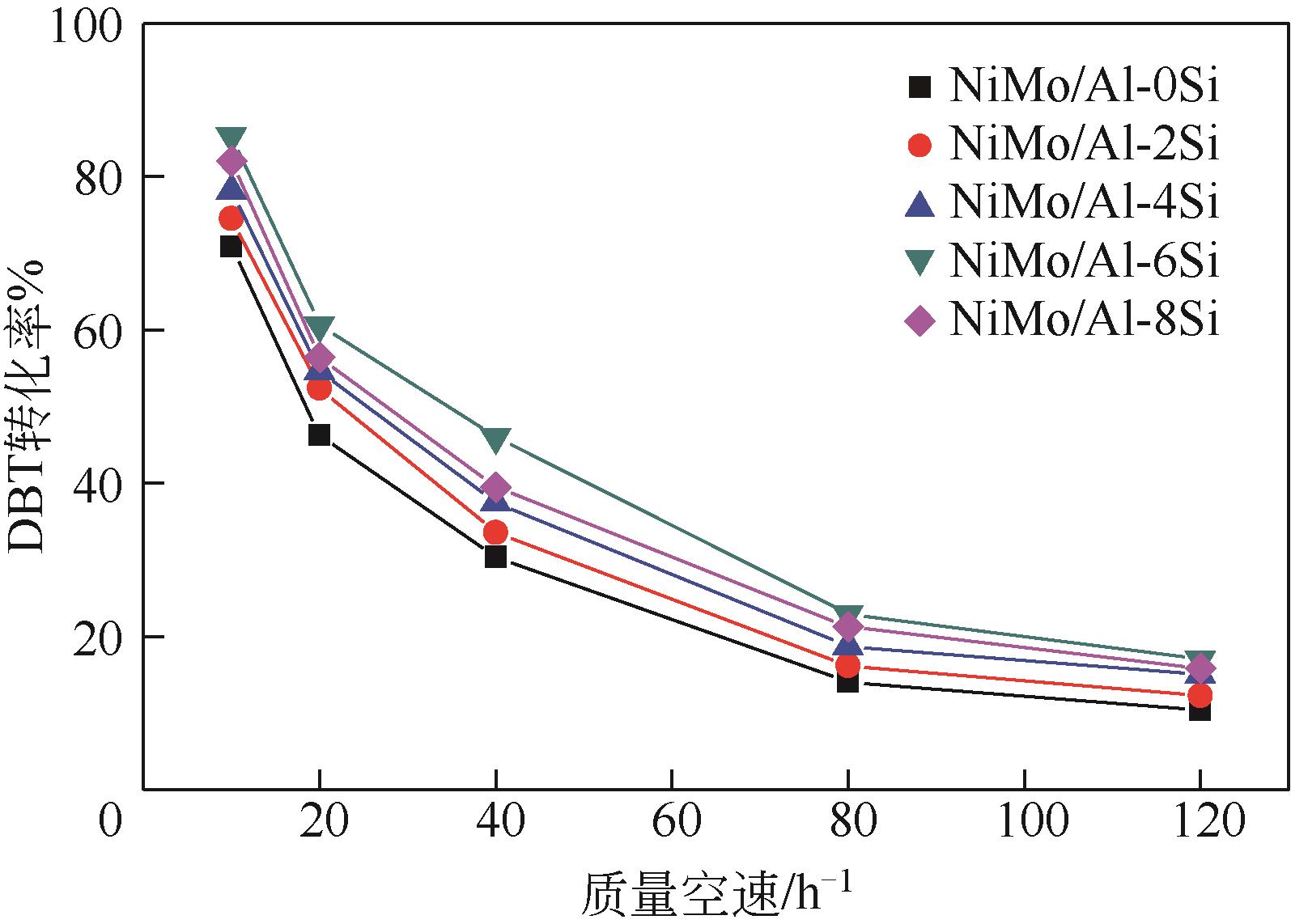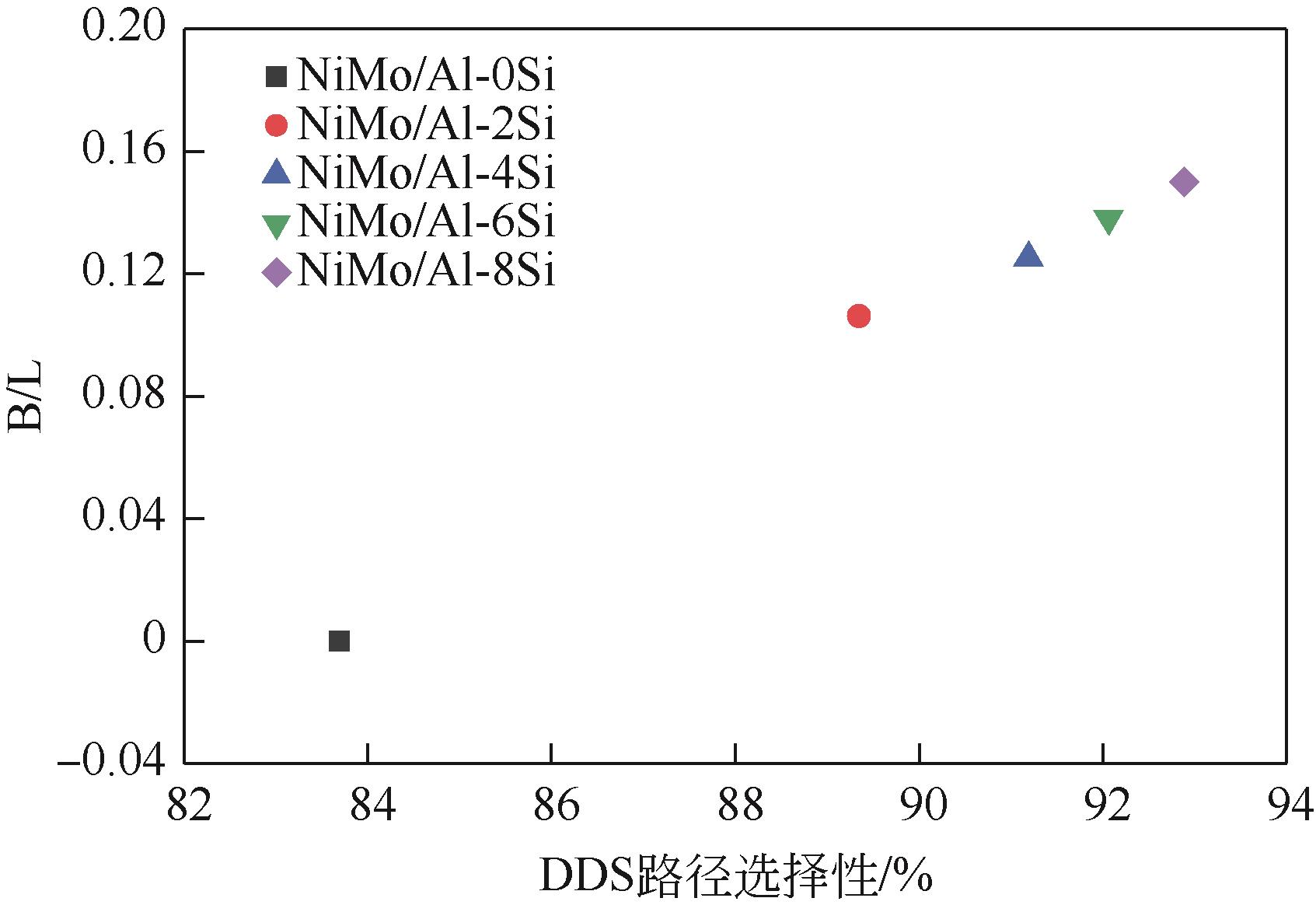Chemical Industry and Engineering Progress ›› 2022, Vol. 41 ›› Issue (S1): 210-220.DOI: 10.16085/j.issn.1000-6613.2022-0241
• Industrial catalysis • Previous Articles Next Articles
Effect of silica modification on the performance of NiMo/Al2O3 catalyst in hydrodesulfurization
GUO Zhenxue1( ), YU Haibin2, ZHANG Guohui2, ZHANG Jingcheng2, LU Yanfei2, HE Yanzhen1, SUN Yanmin2, HAN Enshan1(
), YU Haibin2, ZHANG Guohui2, ZHANG Jingcheng2, LU Yanfei2, HE Yanzhen1, SUN Yanmin2, HAN Enshan1( )
)
- 1.School of Chemical Engineering and Technology, Hebei University of Technology, Tianjin 300401, China
2.CenerTech Tianjin Chemical Research and Design Institute Limited Company, Tianjin 300131, China
-
Received:2022-02-16Revised:2022-05-05Online:2022-11-10Published:2022-10-20 -
Contact:HAN Enshan
Si改性对NiMo/Al2O3催化剂加氢脱硫性能的影响
郭振雪1( ), 于海斌2, 张国辉2, 张景成2, 卢雁飞2, 何艳贞1, 孙彦民2, 韩恩山1(
), 于海斌2, 张国辉2, 张景成2, 卢雁飞2, 何艳贞1, 孙彦民2, 韩恩山1( )
)
- 1.河北工业大学化工学院,天津 300401
2.中海油天津化工研究设计院有限公司,天津 300131
-
通讯作者:韩恩山 -
作者简介:郭振雪(1997—),女,硕士研究生,研究方向为加氢催化剂开发。E-mail:gzxxxue@163.com。 -
基金资助:中国海洋石油集团有限公司“十三五”重大专项(CNOOC-KJ 135 ZDXM 32 TJY 001 TJY 2020)
CLC Number:
Cite this article
GUO Zhenxue, YU Haibin, ZHANG Guohui, ZHANG Jingcheng, LU Yanfei, HE Yanzhen, SUN Yanmin, HAN Enshan. Effect of silica modification on the performance of NiMo/Al2O3 catalyst in hydrodesulfurization[J]. Chemical Industry and Engineering Progress, 2022, 41(S1): 210-220.
郭振雪, 于海斌, 张国辉, 张景成, 卢雁飞, 何艳贞, 孙彦民, 韩恩山. Si改性对NiMo/Al2O3催化剂加氢脱硫性能的影响[J]. 化工进展, 2022, 41(S1): 210-220.
share this article
Add to citation manager EndNote|Ris|BibTeX
URL: https://hgjz.cip.com.cn/EN/10.16085/j.issn.1000-6613.2022-0241
| 催化剂 | 比表面积 /m2·g-1 | 孔体积 /cm3·g-1 | 孔径比例/% | ||
|---|---|---|---|---|---|
| <4nm | 4~10nm | >10nm | |||
| NiMo/Al-0Si | 225 | 0.51 | 8.6 | 73.8 | 17.6 |
| NiMo/Al-2Si | 228 | 0.53 | 6.4 | 75.9 | 17.7 |
| NiMo/Al-4Si | 241 | 0.54 | 5.5 | 76.5 | 18.0 |
| NiMo/Al-6Si | 255 | 0.58 | 4.4 | 77.3 | 18.3 |
| NiMo/Al-8Si | 256 | 0.59 | 2.8 | 78.4 | 18.8 |
| 催化剂 | 比表面积 /m2·g-1 | 孔体积 /cm3·g-1 | 孔径比例/% | ||
|---|---|---|---|---|---|
| <4nm | 4~10nm | >10nm | |||
| NiMo/Al-0Si | 225 | 0.51 | 8.6 | 73.8 | 17.6 |
| NiMo/Al-2Si | 228 | 0.53 | 6.4 | 75.9 | 17.7 |
| NiMo/Al-4Si | 241 | 0.54 | 5.5 | 76.5 | 18.0 |
| NiMo/Al-6Si | 255 | 0.58 | 4.4 | 77.3 | 18.3 |
| NiMo/Al-8Si | 256 | 0.59 | 2.8 | 78.4 | 18.8 |
| 催化剂 | B酸量 /mmol·g-1 | L酸量 /mmol·g-1 | 总酸量 /mmol·g-1 | B/L |
|---|---|---|---|---|
| NiMoS/Al-0Si | — | 0.102 | 0.102 | — |
| NiMoS/Al-2Si | 0.012 | 0.113 | 0.125 | 0.106 |
| NiMoS/Al-4Si | 0.015 | 0.120 | 0.135 | 0.125 |
| NiMoS/Al-6Si | 0.018 | 0.130 | 0.148 | 0.138 |
| NiMoS/Al-8Si | 0.020 | 0.133 | 0.153 | 0.150 |
| 催化剂 | B酸量 /mmol·g-1 | L酸量 /mmol·g-1 | 总酸量 /mmol·g-1 | B/L |
|---|---|---|---|---|
| NiMoS/Al-0Si | — | 0.102 | 0.102 | — |
| NiMoS/Al-2Si | 0.012 | 0.113 | 0.125 | 0.106 |
| NiMoS/Al-4Si | 0.015 | 0.120 | 0.135 | 0.125 |
| NiMoS/Al-6Si | 0.018 | 0.130 | 0.148 | 0.138 |
| NiMoS/Al-8Si | 0.020 | 0.133 | 0.153 | 0.150 |
| 催化剂 | 平均长度/nm | 平均堆垛层数 | fMo |
|---|---|---|---|
| NiMoS/Al-0Si | 3.91 | 2.81 | 0.30 |
| NiMoS/Al-2Si | 3.84 | 3.15 | 0.33 |
| NiMoS/Al-4Si | 3.73 | 3.18 | 0.34 |
| NiMoS/Al-6Si | 3.51 | 3.23 | 0.38 |
| NiMoS/Al-8Si | 3.67 | 3.33 | 0.35 |
| 催化剂 | 平均长度/nm | 平均堆垛层数 | fMo |
|---|---|---|---|
| NiMoS/Al-0Si | 3.91 | 2.81 | 0.30 |
| NiMoS/Al-2Si | 3.84 | 3.15 | 0.33 |
| NiMoS/Al-4Si | 3.73 | 3.18 | 0.34 |
| NiMoS/Al-6Si | 3.51 | 3.23 | 0.38 |
| NiMoS/Al-8Si | 3.67 | 3.33 | 0.35 |
| 催化剂 | Mo4+/% | Mo5+/% | Mo6+/% | NiS x /% | NiMoS/% | NiO/% |
|---|---|---|---|---|---|---|
| NiMoS/Al-0Si | 47.13 | 15.44 | 37.43 | 21.70 | 38.30 | 40.00 |
| NiMoS/Al-2Si | 51.02 | 15.28 | 33.70 | 16.94 | 39.31 | 43.75 |
| NiMoS/Al-4Si | 54.41 | 8.77 | 36.82 | 19.72 | 47.02 | 33.26 |
| NiMoS/Al-6Si | 55.43 | 13.57 | 31.00 | 16.94 | 48.97 | 34.09 |
| NiMoS/Al-8Si | 53.46 | 10.98 | 35.56 | 24.87 | 45.80 | 29.33 |
| 催化剂 | Mo4+/% | Mo5+/% | Mo6+/% | NiS x /% | NiMoS/% | NiO/% |
|---|---|---|---|---|---|---|
| NiMoS/Al-0Si | 47.13 | 15.44 | 37.43 | 21.70 | 38.30 | 40.00 |
| NiMoS/Al-2Si | 51.02 | 15.28 | 33.70 | 16.94 | 39.31 | 43.75 |
| NiMoS/Al-4Si | 54.41 | 8.77 | 36.82 | 19.72 | 47.02 | 33.26 |
| NiMoS/Al-6Si | 55.43 | 13.57 | 31.00 | 16.94 | 48.97 | 34.09 |
| NiMoS/Al-8Si | 53.46 | 10.98 | 35.56 | 24.87 | 45.80 | 29.33 |
| 催化剂 | Ea /kJ·mol-1 | EaDDS /kJ·mol-1 | EaHYD /kJ·mol-1 | KHDS /10-4mol·g-1·h-1 |
|---|---|---|---|---|
| NiMo/Al-0Si | 105.5 | 96.4 | 106.9 | 3.37 |
| NiMo/Al-2Si | 98.5 | 92.5 | 102.2 | 3.80 |
| NiMo/Al-4Si | 93.0 | 90.7 | 97.8 | 4.21 |
| NiMo/Al-6Si | 91.4 | 88.8 | 93.7 | 5.25 |
| NiMo/Al-8Si | 92.4 | 86.7 | 98.3 | 4.67 |
| 催化剂 | Ea /kJ·mol-1 | EaDDS /kJ·mol-1 | EaHYD /kJ·mol-1 | KHDS /10-4mol·g-1·h-1 |
|---|---|---|---|---|
| NiMo/Al-0Si | 105.5 | 96.4 | 106.9 | 3.37 |
| NiMo/Al-2Si | 98.5 | 92.5 | 102.2 | 3.80 |
| NiMo/Al-4Si | 93.0 | 90.7 | 97.8 | 4.21 |
| NiMo/Al-6Si | 91.4 | 88.8 | 93.7 | 5.25 |
| NiMo/Al-8Si | 92.4 | 86.7 | 98.3 | 4.67 |
| 催化剂 | DDS(BP①)/% | HYD/% | 转化率(DBT)/% | |||
|---|---|---|---|---|---|---|
| THDBT② | HHDBT③ | CHB④ | DCH⑤ | |||
| NiMo/Al-0Si | 83.69 | 0.33 | 13.13 | 0.52 | 2.33 | 49.59 |
| NiMo/Al-2Si | 89.35 | 0.14 | 7.94 | 0.42 | 2.15 | 49.63 |
| NiMo/Al-4Si | 91.20 | 0.13 | 6.46 | 0.27 | 1.94 | 50.25 |
| NiMo/Al-6Si | 92.07 | 0.20 | 5.74 | 0.09 | 1.90 | 50.00 |
| NiMo/Al-8Si | 92.89 | 0.13 | 4.75 | 0.28 | 1.95 | 49.70 |
| 催化剂 | DDS(BP①)/% | HYD/% | 转化率(DBT)/% | |||
|---|---|---|---|---|---|---|
| THDBT② | HHDBT③ | CHB④ | DCH⑤ | |||
| NiMo/Al-0Si | 83.69 | 0.33 | 13.13 | 0.52 | 2.33 | 49.59 |
| NiMo/Al-2Si | 89.35 | 0.14 | 7.94 | 0.42 | 2.15 | 49.63 |
| NiMo/Al-4Si | 91.20 | 0.13 | 6.46 | 0.27 | 1.94 | 50.25 |
| NiMo/Al-6Si | 92.07 | 0.20 | 5.74 | 0.09 | 1.90 | 50.00 |
| NiMo/Al-8Si | 92.89 | 0.13 | 4.75 | 0.28 | 1.95 | 49.70 |
| 1 | WANG H Y, LIU S D, SMITH K J. Understanding selectivity changes during hydrodesulfurization of dibenzothiophene on Mo2C/carbon catalysts[J]. Journal of Catalysis, 2019, 369: 427-439. |
| 2 | ZHOU W W, WEI Q, ZHOU Y S, et al. Hydrodesulfurization of 4,6-dimethyldibenzothiophene over NiMo sulfide catalysts supported on meso-microporous Y zeolite with different mesopore sizes[J]. Applied Catalysis B: Environmental, 2018, 238: 212-224. |
| 3 | ZHOU W W, ZHOU A N, ZHANG Y T, et al. Hydrodesulfurization of 4,6-dimethyldibenzothiophene over NiMo supported on Ga-modified Y zeolites catalysts[J]. Journal of Catalysis, 2019, 374: 345-359. |
| 4 | WANG X L, MEI J L, ZHAO Z, et al. Restrictive diffusion in the hydrodesulfurization over Ni-MoS2/Al2O3 with different crystal forms[J]. Industrial & Engineering Chemistry Research, 2017, 56(36): 10018-10027. |
| 5 | GRØNBORG S S, ŠARIĆ M, MOSES P G, et al. Atomic scale analysis of sterical effects in the adsorption of 4,6-dimethyldibenzothiophene on a CoMoS hydrotreating catalyst[J]. Journal of Catalysis, 2016, 344: 121-128. |
| 6 | JAF Z N, ALTARAWNEH M, MIRAN H A, et al. Hydrodesulfurization of thiophene over γ-Mo2N catalyst[J]. Molecular Catalysis, 2018, 459: 21-30. |
| 7 | TOPSØE H, CLAUSEN B S, CANDIA R, et al. In situ Mössbauer emission spectroscopy studies of unsupported and supported sulfided CoMo hydrodesulfurization catalysts: evidence for and nature of a CoMoS phase[J]. Journal of Catalysis, 1981, 68(2): 433-452. |
| 8 | YU Q, ZHANG J C, NAN J, et al. Synthesis and hydrodesulfurization performance of NiMo sulfide catalysts supported on an Al-Si mixed oxide[C]//Preceedings of the 2016 International Conference on Civil, Architecture and Environmental Engineering. Taibei, China, 2017: 404-407. |
| 9 | RAYO P, TORRES-MANCERA P, CENTENO G, et al. Effect of silicon incorporation method in the supports of NiMo catalysts for hydrotreating reactions[J]. Fuel, 2019, 239: 1293-1303. |
| 10 | ROMERO-GALARZA A, RAMíREZ J, GUTIÉRREZ-ALEJANDRE A, et al. Relevant changes in the properties of Co(Ni)Mo/Al2O3 HDS catalysts modified by small amounts of SiO2 [J]. Journal of Materials Research, 2018, 33(21): 3570-3579. |
| 11 | ABOUTALEB W A, NAGGER A M A EL, SAYED M A, et al. Influence of CeO2 loading on the catalytic performance of CoNiMoS/CeO2-Al2O3 toward vacuum gas oil hydrotreatment[J]. Materials Chemistry and Physics, 2022, 276: 125165. |
| 12 | WANG S, ZHANG J C, LIU D, et al. Deep insights into enhanced direct-desulfurization selectivity of thiourea-modified CoMoP/ γ-Al2O3: an investigation of catalyst microstructures[J]. Fuel, 2020, 267: 116993. |
| 13 | 张国辉, 张玉婷, 张景成, 等. 制备方法对Ni-Mo/Al2O3加氢催化剂性能的影响[J]. 化工进展, 2018, 37(11): 4315-4321. |
| ZHANG Guohui, ZHANG Yuting, ZHANG Jingcheng, et al. Influence of preparation method on hydrotreating activity of Ni-Mo/Al2O3 [J]. Chemical Industry and Engineering Progress, 2018, 37(11): 4315-4321. | |
| 14 | 汪佩华, 秦志峰, 吴琼笑, 等. 磷添加方式对NiMo/Al2O3催化剂加氢脱硫性能的影响[J]. 化工进展, 2021, 40(2): 890-900. |
| WANG Peihua, QIN Zhifeng, WU Qiongxiao, et al. Effect of phosphorus adding manners on the performance of NiMo/Al2O3 catalyst in hydrodesulfurization[J]. Chemical Industry and Engineering Progress, 2021, 40(2): 890-900. | |
| 15 | ŠARIĆ M, ROSSMEISL J, MOSES P G. Modeling the adsorption of sulfur containing molecules and their hydrodesulfurization intermediates on the Co-promoted MoS2 catalyst by DFT[J]. Journal of Catalysis, 2018, 358: 131-140. |
| 16 | CAO Z K, ZHANG X, GUO R, et al. Synergistic effect of acidity and active phases for NiMo catalysts on dibenzothiophene hydrodesulfurization performance[J]. Chemical Engineering Journal, 2020, 400: 125886. |
| 17 | LIU B, LIU L, WANG Z, et al. Effect of hydrogen spillover in selective hydrodesulfurization of FCC gasoline over the CoMo catalyst[J]. Catalysis Today, 2017, 282: 214-221. |
| 18 | HENKER M, WENDLANDT K P, VALYON J, et al. Structure of MoO3/Al2O3-SiO2 catalysts[J]. Applied Catalysis, 1991, 69(1): 205-220. |
| 19 | ARNOLDY P, JONGE J D, MOULIJN J. Temperature-programed reduction of molybdenum (Ⅵ) oxide and molybdenum (Ⅳ) oxide[J]. The Journal of Physical Chemistry, 1985, 89(21): 4517-4526. |
| 20 | 岳凡, 李蒙, 杨祝红, 等. 介孔TiO2晶须-γ-Al2O3复合载体催化剂的制备及对二苯并噻吩的加氢脱硫性能[J]. 石油学报(石油加工), 2020, 36(4): 667-676. |
| YUE Fan, LI Meng, YANG Zhuhong, et al. Preparation of mesoporous TiO2 whisker-γ-Al2O3 composite supported catalyst and its catalytic performance in dibenzothiophene hydrodesulfurization[J]. Acta Petrolei Sinica (Petroleum Processing Section), 2020, 36(4): 667-676. | |
| 21 | RAJAGOPAL S, MARINI H, MARZARI J, et al. Silica-alumina-supported acidic molybdenum catalysts-TPR and XRD characterization[J]. Journal of Catalysis, 1994, 147(2): 417-428. |
| 22 | XU J, HUANG T, FAN Y. Highly efficient NiMo/SiO2-Al2O3 hydrodesulfurization catalyst prepared from gemini surfactant-dispersed Mo precursor[J]. Applied Catalysis B: Environmental, 2017, 203: 839-850. |
| 23 | HAO L, XIONG G, LIU L P, et al. Preparation of highly dispersed desulfurization catalysts and their catalytic performance in hydrodesulfurization of dibenzothiophene[J]. Chinese Journal of Catalysis, 2016, 37(3): 412-419. |
| 24 | GLOTOV A P, VUTOLKINA A V, VINOGRADOV N A, et al. Enhanced HDS and HYD activity of sulfide Co-PMo catalyst supported on alumina and structured mesoporous silica composite[J]. Catalysis Today, 2021, 377: 82-91. |
| 25 | HARRIS S, CHINANELLI R R. Catalysis by transition metal sulfides: the relation between calculated electronic trends and HDS activity[J]. Journal of Catalysis, 1984, 86(2): 400-412. |
| 26 | SÁNCHEZ-MINERO F, RAMÍIREZ J, NCHEZ-MINERO F, et al. Analysis of the HDS of 4,6-DMDBT in the presence of naphthalene and carbazole over NiMo/Al2O3-SiO2(x) catalysts[J]. Catalysis Today, 2008, 133: 267-276. |
| 27 | PRINS R, EGOROVA M, RÖTHLISBERGER A, et al. Mechanisms of hydrodesulfurization and hydrodenitrogenation[J]. Catalysis Today, 2006, 111(1-2): 84-93. |
| 28 | 赵瑞玉, 曹东炜, 曾令有, 等. 助剂Ni与载体的相互作用及其对NiMo/γ-Al2O3催化剂加氢脱硫性能的影响[J]. 燃料化学学报, 2016, 44(5): 564-569. |
| ZHAO Ruiyu, CAO Dongwei, ZENG Lingyou, et al. Interaction between Ni promoter and Al2O3 support and its effect on the performance of NiMo/γ-Al2O3 catalyst in hydrodesulphurization[J]. Journal of Fuel Chemistry and Technology, 2016, 44(5): 564-569. | |
| 29 | LÓPEZ-BENÍTEZ A, BERHAULT G, GUEVARA-LARA.A. Addition of manganese to alumina and its influence on the formation of supported NiMo catalysts for dibenzothiophene hydrodesulfurization application[J]. Journal of Catalysis, 2016, 344: 59-76. |
| 30 | LEBEAU B, BONNE M, COMPAROT J D, et al. HDS of 4,6-dimethyldibenzothiophene over CoMoS supported mesoporous SiO2-TiO2 materials[J]. Catalysis Today, 2020: 675-683. |
| 31 | 李翔, 王安杰, 柳广厦, 等. 芳香杂环含硫化合物C—S键断裂方式[J]. 石油学报(石油加工), 2017, 33(6): 1039-1052. |
| LI Xiang, WANG Anjie, LIU Guangxia, et al. Mechanisms of the cleavage of C—S Bonds in polyaromatic sulfur-containing compounds[J]. Acta Petrolei Sinica (Petroleum Processing Section), 2017, 33(6): 1039-1052. |
| [1] | ZHANG Mingyan, LIU Yan, ZHANG Xueting, LIU Yake, LI Congju, ZHANG Xiuling. Research progress of non-noble metal bifunctional catalysts in zinc-air batteries [J]. Chemical Industry and Engineering Progress, 2023, 42(S1): 276-286. |
| [2] | SHI Yongxing, LIN Gang, SUN Xiaohang, JIANG Weigeng, QIAO Dawei, YAN Binhang. Research progress on active sites in Cu-based catalysts for CO2 hydrogenation to methanol [J]. Chemical Industry and Engineering Progress, 2023, 42(S1): 287-298. |
| [3] | XIE Luyao, CHEN Songzhe, WANG Laijun, ZHANG Ping. Platinum-based catalysts for SO2 depolarized electrolysis [J]. Chemical Industry and Engineering Progress, 2023, 42(S1): 299-309. |
| [4] | YANG Xiazhen, PENG Yifan, LIU Huazhang, HUO Chao. Regulation of active phase of fused iron catalyst and its catalytic performance of Fischer-Tropsch synthesis [J]. Chemical Industry and Engineering Progress, 2023, 42(S1): 310-318. |
| [5] | WANG Lele, YANG Wanrong, YAO Yan, LIU Tao, HE Chuan, LIU Xiao, SU Sheng, KONG Fanhai, ZHU Canghai, XIANG Jun. Influence of spent SCR catalyst blending on the characteristics and deNO x performance for new SCR catalyst [J]. Chemical Industry and Engineering Progress, 2023, 42(S1): 489-497. |
| [6] | DENG Liping, SHI Haoyu, LIU Xiaolong, CHEN Yaoji, YAN Jingying. Non-noble metal modified vanadium titanium-based catalyst for NH3-SCR denitrification simultaneous control VOCs [J]. Chemical Industry and Engineering Progress, 2023, 42(S1): 542-548. |
| [7] | CHENG Tao, CUI Ruili, SONG Junnan, ZHANG Tianqi, ZHANG Yunhe, LIANG Shijie, PU Shi. Analysis of impurity deposition and pressure drop increase mechanisms in residue hydrotreating unit [J]. Chemical Industry and Engineering Progress, 2023, 42(9): 4616-4627. |
| [8] | WANG Peng, SHI Huibing, ZHAO Deming, FENG Baolin, CHEN Qian, YANG Da. Recent advances on transition metal catalyzed carbonylation of chlorinated compounds [J]. Chemical Industry and Engineering Progress, 2023, 42(9): 4649-4666. |
| [9] | ZHANG Qi, ZHAO Hong, RONG Junfeng. Research progress of anti-toxicity electrocatalysts for oxygen reduction reaction in PEMFC [J]. Chemical Industry and Engineering Progress, 2023, 42(9): 4677-4691. |
| [10] | GE Quanqian, XU Mai, LIANG Xian, WANG Fengwu. Research progress on the application of MOFs in photoelectrocatalysis [J]. Chemical Industry and Engineering Progress, 2023, 42(9): 4692-4705. |
| [11] | WANG Weitao, BAO Tingyu, JIANG Xulu, HE Zhenhong, WANG Kuan, YANG Yang, LIU Zhaotie. Oxidation of benzene to phenol over aldehyde-ketone resin based metal-free catalyst [J]. Chemical Industry and Engineering Progress, 2023, 42(9): 4706-4715. |
| [12] | GE Yafen, SUN Yu, XIAO Peng, LIU Qi, LIU Bo, SUN Chengying, GONG Yanjun. Research progress of zeolite for VOCs removal [J]. Chemical Industry and Engineering Progress, 2023, 42(9): 4716-4730. |
| [13] | WANG Shangbin, OU Hongxiang, XUE Honglai, CAO Haizhen, WANG Junqi, BI Haipu. Effect of xanthan gum and nano silica on the properties of fluorine-free surfactant mixed solution foam [J]. Chemical Industry and Engineering Progress, 2023, 42(9): 4856-4862. |
| [14] | SONG Weitao, SONG Huiping, FAN Zhenlian, FAN Biao, XUE Fangbin. Research progress of fly ash in anti-corrosion coatings [J]. Chemical Industry and Engineering Progress, 2023, 42(9): 4894-4904. |
| [15] | WU Haibo, WANG Xilun, FANG Yanxiong, JI Hongbing. Progress of the development and application of 3D printing catalyst [J]. Chemical Industry and Engineering Progress, 2023, 42(8): 3956-3964. |
| Viewed | ||||||
|
Full text |
|
|||||
|
Abstract |
|
|||||
